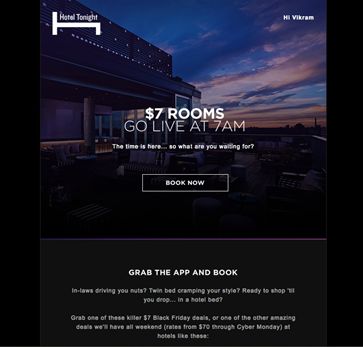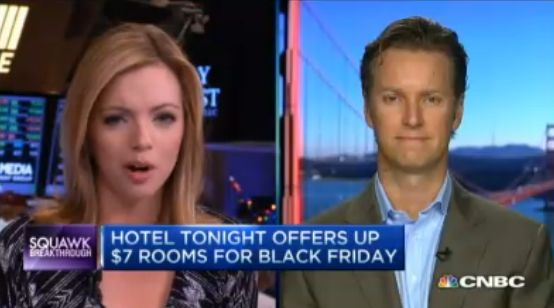
by Vikram Singh
This Thanksgiving holiday in the US was an eventful one for the hospitality industry. What got my attention was the Black Friday offer of $7 rooms on Hotel Tonight (my favorite mobile travel app). Important: Before you read this – No matter who got paid how much in the end or what the real breakup of advertised rate versus actual payment made by Hotel Tonight was was like. The fact is that the guest paid $7 for booking those hotels and that is what he/she will remember.
Hotels all over the US participated in this spectacular deal. Based on my zip code, Hotel Tonight sent me an email informing me that the following hotels in the Midwest were participating:
- The Godfrey Chicago
- The Edgewater Madison
- The Kinzie Chicago
- The Pfister Hotel Milwaukee
- The Hotel Minneapolis (a Marriott “Autograph Collection” hotel)
All were all offering a $7 rooms for a limited time starting at 7 am.
In general, discounting your rooms is not a great idea. But this super-aggressive deep discounting is a whole new dark territory. It’s not a good place for the industry to be, especially at a time when hotels and brands are struggling so hard to define their value thanks to hyper-successful travel startups like Airbnb. This is scary on many levels. I am talking Wes Craven* and Eli Roth level scary.
*Sam Shank, Founder & CEO of Hotel Tonight, was an assistant to Wes Craven on the film Scream.
No matter how bad the market is, I am not a fan of discounting and never will be. Sure, discounting will fill your hotel…but at what cost? Who is this guest checking into your hotel for $7? What happens to your value perception? The fact is that you are better off giving away a free room instead of attaching a $7 rate to your product. Hotels dropping rates might appear to be winning the occupancy battle, but it pretty much ends there. When it comes to long-term profitability, GoPar and RevPar growth favor hotels who protect the value of their product.
A Great Win for Hotel Tonight
As far as creating buzz, this was an absolute win for Hotel Tonight. Sam went all the way to CNBC with his amazing “Get your $7 hotel room now!” segment. Kudos.
I’m sure Hotel Tonight reached several hundred thousand new people who now know about their wonderful deal-generating, money-saving, last-minute booking app. Are they the “enemy” for promoting themselves? Absolutely not. Likewise, I have always admired OTA’s for focusing their efforts where it truly matters: Online. Besides, anyone who is making travel better and easier for customers is in my good book.
Hotel Tonight has indeed taken mobile usability and distribution to a new level; none of the established hotel brands like Marriott, Hilton, Starwood etc. have even come close. I strongly encourage everyone in the travel business to take note of how well the Hotel Tonight App functions.
Deep Discounting Damages Your Brand and Revenue
Mo’ Discounts, Mo’ Problems (RIP Biggie)
Deep discounting conditions guests to de-value your hotel product. Value, like beauty, is not just in the eye of the beholder…. it’s based on what the beholder paid for it. Here is a chart showing the average rates I found on the participating hotels’ websites (most basic room type, for one-night stay, December 8, 2015):
A severely discounted room rate also has a negative impact on your ongoing marketing and brand building efforts. Once you make public that a room at your fine hotel can be rented for a rock bottom rate of $7, you have created a baseline expectation that is way too low. Boosting your perceived value from $7 all the way up to your regular rate is a mighty task that you did not need to add for yourself. You can quote me on this: It takes years to build your rate, and a moment to destroy it.
To further complicate things, you are not the only hotel in the market. People will associate your competition with higher rates and therefore better overall quality. You will have to deal with this brand erosion long after the excitement of your $7 discount offer wears off.
Healthy Alternatives to Deep Discounting
Got your back against the wall? Low occupancy got you down? Want to create “buzz” for your slow season/dates? Here are some better options for you to consider:
Offer value, not discounts.
There are many ways to make your guest feel all warm and fuzzy. How about offering something extra rather than a rate discount? Adding something extra makes your customers feel they are getting something special instead of attracting bargain-hunters; and it doesn’t cost you your dignity.
Reward loyalty.
How about a special value-added holiday rate plan for your most loyal guests? Create a rate tier for them that they can use during the holidays and lean periods at your hotel. They will feel pampered by receiving extra amenities, and you’ll fill rooms with customers who like you (and vice versa).
Shift your revenue model.
How about a revenue system based on your guests’ overall value? Nobody should ever be sold a $7 room. But a case can be made for offering extras and upgrades to your most profitable guests – the ones who stay with you frequently and/or buy meals, drinks, spa services, etc. Airlines and casinos do this every day. As an elite frequent flier, I love that my total value is considered even on a small flight that I’m taking from point A to point B.
Segment better.
Whom are you selling to? Have you created segments that are priced to trigger bookings? Mass marketing and discounting are so 2001. Every hotel should be working on better segmenting every year based on geographical, corporate, and income-based data from their online and offline analytics.
Conclusion
Discounting is dead. Granted, it’s a zombie that comes back to life every now and then when hotel owners, managers and marketers completely run out of ideas. But you don’t have to be a victim of zombie discounting. There are many other approaches that can help you through a slow season.
I hope that next year on Black Friday we do not see any more $7 hotel rooms. Instead, I would love to see hotels offering great value to their guests for the holiday season, through creative outreach, packaging and upgrades. Going after a sustainable revenue strategy is harder. But, as is often true in life, the harder thing to do is also the right thing to do.




